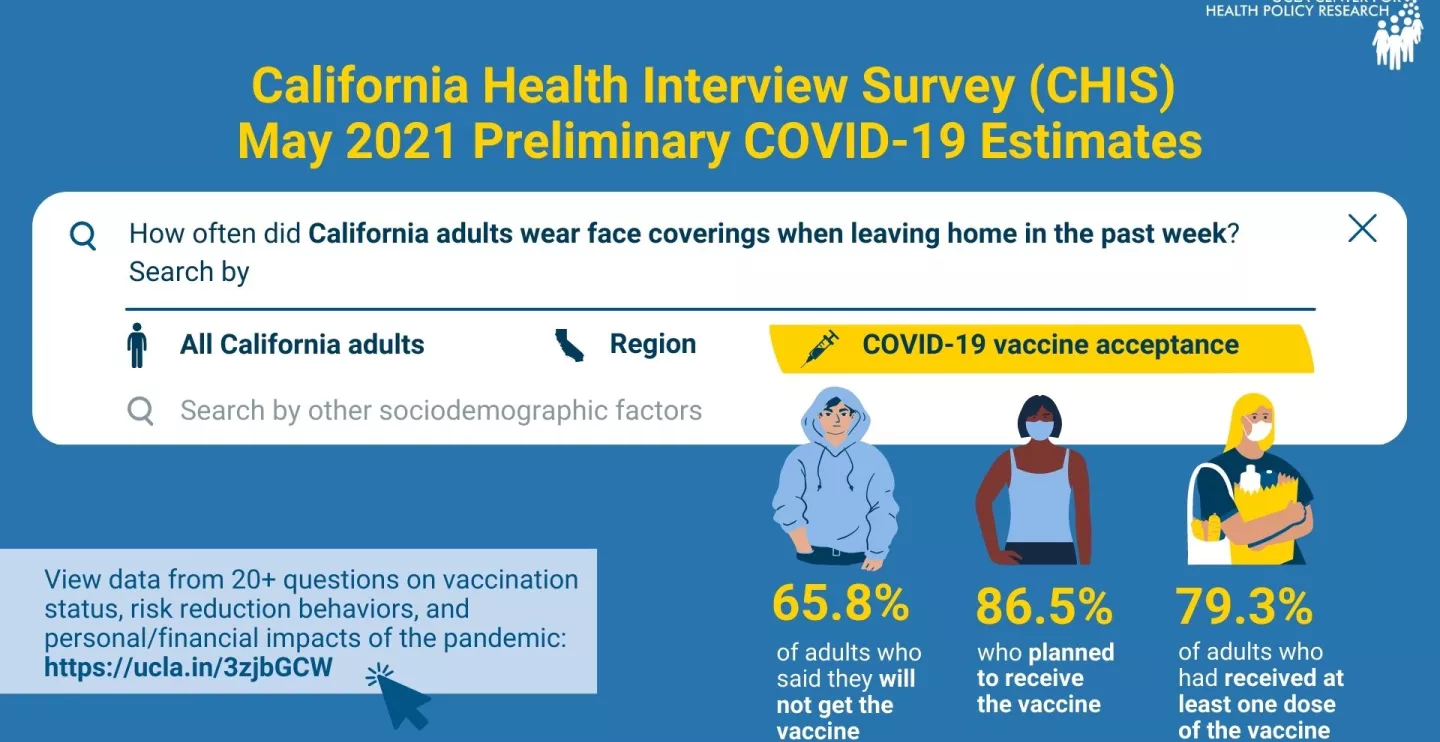Did Californians continue to follow COVID-19 state and local safety guidelines as case and death rates declined? The UCLA Center for Health Policy Research (CHPR) has released May 2021 data from the California Health Interview Survey (CHIS) that sheds more light on whether individuals continued to follow suggested safety protocols such as wearing face coverings and gathering with people outside of the household. The 2020 survey also included questions on how the pandemic impacted people personally and financially.
The ;latest update to the 2021 CHIS COVID-19 Preliminary Estimates Dashboard, which includes CHIS 2021 data collected from March through May, has questions on risk reduction behaviors — frequency of wearing face masks, handwashing or sanitizing, maintaining physical distancing, gathering with individuals outside of the household and following safety guidelines during those times — as well as questions on views of the vaccine, testing and treatment. The March and April estimates were released in July 2021.
“In an effort to update the public and stakeholders on how the pandemic impacted people’s lives, we are releasing monthly estimates to gauge the status on whether Californians are adhering to either mandated or suggested safety guidelines put forth by federal, state, or local agencies and understanding where there may continue to be gaps in vaccine acceptance,” said Ninez A. Ponce, PhD, MPP, director of UCLA CHPR and CHIS principal investigator. “This data provides the latest updates to health and community organizations, as well as policymakers, on where targeted efforts can be made to ensure that we can safely navigate out of the pandemic, especially amidst the surge of the new Delta variant.”
Key findings from the May 2021 data include:
Risk reduction behaviors
Californians reported slightly lower rates for “always” wearing a face covering when leaving their homes: 79.1% of adults said that they “always” wore a face covering, compared to 84.8% in the March and April months of 2021. 65.8% of adults who didn’t plan on getting the vaccine reported “always” wearing a face covering when leaving their homes.
Californians also reported higher rates of gathering with people outside of their household in the past 30 days: 58.7% of adults said they gathered with people outside of their household, compared to 53.1% in March and April. 61.7% of individuals who had received at least one dose of the vaccine gathered with people outside of their homes, compared with 56.8% of adults who did not plan to get vaccinated.
Vaccine attitudes
Fewer people reported that they would not get the vaccine: 10.3% said they did not plan on getting the vaccine in May vs. 12% in March/April.
Adults in different geographic regions had differences in whether or not they would get the vaccine: Californians in the Northern/Sierra counties were nearly 10 times more likely to say they would not receive the COVID-19 vaccine compared to the Greater Bay Area — 27.4% vs. 2.8% in May. Individuals in the Northern/Sierra counties were also less likely to receive at least one dose of the vaccine when compared to the Greater Bay Area — 61.3% vs. 85.5%, respectively.
COVID-19 testing and treatment
Disparities persisted in which racial and ethnic groups were more likely to report testing positive for COVID-19: Latino adults reported the highest rates of testing positive at 24.7% in May and 25% in March/April. They were also one of the more likely racial and ethnic groups to report continuing to work in essential positions at 26.5% in May and 28.3% in March/April.
Personal and Financial Impacts
Adults in regions that were less likely to report planning to get the vaccine were most likely report continuing to work in essential roles: 32.9% of adults in the Northern Sierra region said they continued to work in essential jobs and were also most likely out of all of the regions to say they wouldn’t get the vaccine.
Adults reported similar rates regarding being treated unfairly due to race/ethnicity: 2.6% reported being treated unfairly in May and 2.8% in March/April.
“We want the 2021 CHIS data to provide a clearer picture to help various groups in the state to safely navigate out of the pandemic as well as help individuals who are most in need of medical, personal, and financial support. The data we’re compiling sheds light on areas and groups that need help, and how to assist them,” said Todd Hughes, CHIS director.
UCLA CHPR is providing regular updates to another tracking dashboard that looks at COVID-19 infection and death rates across racial and ethnic groups in the Native Hawaiian and Pacific Islander communities. Check out the latest statistics in our Native Hawaiian and Pacific Islander (NHPI) COVID-19 Data Policy Lab Dashboard.
The UCLA Center for Health Policy Research (CHPR) is one of the nation’s leading health policy research centers and the premier source of health policy information for California. UCLA CHPR improves the public’s health through high quality, objective, and evidence-based research and data that informs effective policymaking. UCLA CHPR is the home of the California Health Interview Survey (CHIS) and is part of the UCLA Fielding School of Public Health and affiliated with the UCLA Luskin School of Public Affairs.




